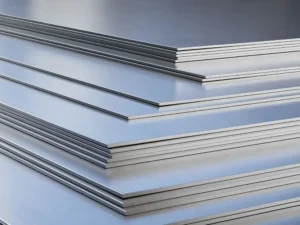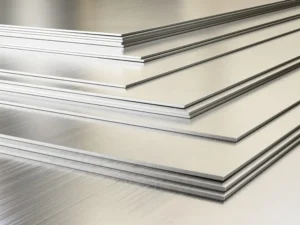While talking about metals, you must have heard about metal sheets and plates. Many of us think that they are the same things. We are way off, considering them as one, but they are worlds apart. There are many differences between metal sheets and plates.
Are you involved in the manufacturing industry? You would use both of them. So, it is vital to understand their differences. If you don’t understand, you’ll end up with the wrong one when choosing for your specific project. However, this guide will debunk all the differences. So, stick around!
Overview of Metal Sheet and Plate

Both metal sheets and plat differ in terms of their thickness. Plates generally have a thickness above 6mm. On the flip side, the sheet’s thickness ranges between 0.5 and 6mm. Its thickness is always under 6mm. Moreover, their production processes also vary.
Both metal sheets and plates have distinct importance in different industries. For example, metal plates are generally suitable for the construction industry. The reason is that it has a higher thickness and can bear the stress. On the flip side, metal sheets are ideal for the automobile industry.
Manufacturers use these for making the car’s body and roofing. It is generally less robust than metal plates. These sheets can be made of different materials. Those include aluminum, stainless steel, and so on. It indicates that you get a variety of material options when choosing plates and sheets.
Quick Tip: The manufacturers use inches as a unit to measure the thickness of metal plates. On the other hand, they use gauges as a unit for measuring the thickness of metal sheets. Their thicknesses are significantly different, which gives them different properties and uses.
Metal Sheet vs. Plate: Key Differences
As I said above, knowing the difference between metal sheets and plates is very important for any project. If you comprehend the differences, you will only then be able to use them correctly. To help you out, let’s try to understand the key differences.
1- Production Process
The significant difference between metal and sheet is in their manufacturing process. Both undergo a heating process, but their rolling process varies. Metal sheets are generally cold-rolled, which means they are under a series of rollers, and the temperature remains low.
On the flip side, plate production also involves undergoing a roller series. But the process involves rolling at a very high temperature. Moreover, metal plates undergo some additional treatment. This gives plates more stability and strength.
Simply put, making metal sheets involves keeping the temperature below the crystallization point. This process makes the sheets malleable and easy to bend. But for metal plates, the heat is above the crystallization point. These high and low temperatures give them different properties.
2- Structural Integrity

Due to the difference in thickness, metal sheets and plates have different structural integrity. Less thickness means a weaker structure. So, it is evident that the sheets don’t have a strong structure, but they are flexible, malleable, and bendable.
If your project demands a highly flexible structure, metal sheets are recommended. Inversely, metal plates have a strong structure due to their thickness. This structure allows them to combat extreme conditions without bending. They offer long-term durability, which is the demand for ultra-critical projects.
3- Versatility
Due to their bending property, metal sheets are incredibly versatile. They can be transformed into different shapes without breaking. Architects benefit from these sheets’ versatility for the aesthetic look of their art. Moreover, manufacturers use sheets to make parts.
However, metal plates are less versatile due to their extra thickness and robustness. But it doesn’t mean they lose their importance due to a lack of versatility. Their scope is high in construction industries that do not ask for versatility. Indeed, metal plates cannot be reshaped, but they can be welded if required.
4- Fabrication and Processing

Generally, metals with less thickness are easy to fabricate. Sheets, therefore, are easy to process as they are thin and bendable. Their rolling process occurs at room temperature, reducing the need for extra effort. Moreover, their fabrication requires simple pieces of equipment.
In contrast, the processing of metal plates is not very straightforward. Manufacturers have to use high-powered tools to cut and process these plates. Those include plasma cutting, CNC machining, and waterjet, which are used for fabrication. One thing that I would mention is the impact of their making material on their fabrication.
Remember that a sheet made of stainless steel would be solid. This potent material (stainless steel) makes the sheet strong and slightly hard to cut. The same goes for plates made of stainless steel. However, their cutting and processing become easier if their material is weaker.
5- Weight and Handling
Metal sheets are advantageous for handling due to their lightweight. You can easily use and install them. They are easy to bend with standard tools and can be transported to manufacturing sites. Moreover, this easy-handling benefit increases the speed of your projects. This is one of the reasons behind its popularity.
On the other hand, metal plates are much heavier. This is not bad, as this weight gives the plate more strength. However, this high strength comes with a trade-off. Due to their high weight, handling them can be challenging. Moreover, their transportation from one location to another is also tedious.
6- Applications & Uses
Metal sheets are widely used in automobiles. Their lightweight engine benefits smooth performance. Moreover, they are common in making vehicle bodies and roofing. Their flexibility is used in the formation of decoration pieces. The aerospace industry also uses these sheets.
On the other hand, metal plates are used to manufacture heavy-duty parts and components. Gas and oil companies also use them to form tanks. Bridge-building projects never neglect their use. However, their usage is standard in the construction industry to make strong structures.
7- Cost & Affordability
The cost of metal sheets and plates depends on various factors. Metal sheets are usually less expensive than metal plates. Let me tell you the reason. Their production process is relatively more straightforward. Metal plates are super costly, as they undergo additional treatment for their strength.
Thickness is another factor that affects their cost. An increase in thickness requires more raw materials. A metal plate with a 20mm thickness costs more than twice that of a 10mm plate of the same material. The same goes for metal sheets. However, metal sheets are always less expensive than plates.
Which One Should You Choose: A Metal Plate or a Sheet?
The selection between metal plates and sheets depends on your needs and preferences. Metal plates are suitable when you require strength and durability. However, metal sheets are the best if you need flexibility. Both offer unique properties.
Remember that the price of metal plates and sheets can influence their selection. Metal sheets are less expensive. If you want to keep your project on the lower side, metal sheets would be an option. I highly recommend choosing plates if you are an engineer working on a building project.
The reason is that these plates are strong and capable of bearing weight and stress. Are you working in the automobile industry? You should choose metal sheets. The reason is that their low weight will make parts with less weight. As a result, Chile’s fuel efficiency has improved. Want to know which one is better?
Both are excellent and offer unique properties. If you choose a sheet for construction, you’ll be at a loss. Similarly, selecting plates for the automobile industry is not a good move. So, make sure to decide their selection based on their properties. Their performance will impress you if you select them, considering their strengths and weaknesses.
Frequently Asked Questions
Which is lighter: metal sheets or metal plates?
Metal sheets are lighter than metal plates. Their thickness ranges between 0.5mm to 6mm. The metal plates are very thick, which increases their weight.
Can metal sheets be used for heavy-duty applications?
No, metal sheets are not applicable for heavy loads. They are lightweight and cannot endure such heavy-duty applications.
Which material is better for structural support?
Metal plates are preferred for structural support due to their durability and extreme strength. Their higher thickness also improves their structural support. Therefore, manufacturers use them in the construction industry.
Is stainless steel used for both metal sheets and plates?
Yes, stainless steel is used for both sheets and plates. Stainless steel gives them extra corrosion resistance.
Conclusion
Knowing the primary differences between metal sheets and metal plates is crucial. Ignoring this difference can impact your manufacturing process. Mistakes in their selection will cost you time and money and cause headaches. Therefore, I have mentioned everything about metal sheets vs plates.
In summary, metal sheets are thin, flexible, bendable, and inexpensive. On the contrary, the metal plates are super expensive and robust. Due to their durability, their high prices are worth your investment. Hopefully, this article will make most of the sense. In the end, you’ll be able to make informed buying decisions.
